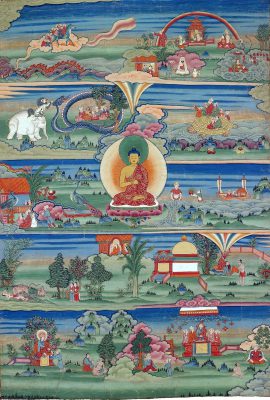Buddha's Meditation Technique to Tap into Your Past Lives

After 20 years of intensive searching we've finally been able to know the "Buddha's Meditation Technique to Tap into Your Past Lives" And share it with you!
May You Be Enlightened
May You Attain Nirvana!
In Buddhism, there are various meditation techniques that practitioners use to gain insight and understanding of past lives. One such technique is known as “jati smaran” or “recollection of past lives.” This practice involves developing a focused and concentrated mind to access the memories and experiences of past lives.
The jati smaran meditation technique typically involves the following steps:
Calming the mind: Begin by cultivating a state of calmness and relaxation through deep breathing and mindfulness meditation. This helps to quiet the mind and create a conducive environment for deep introspection.
Concentration: Develop concentration by focusing on a single object or anchor, such as the breath or a visualized image. This helps to stabilize the mind and cultivate a heightened level of awareness.
Regression: Once the mind is sufficiently concentrated, direct your attention towards exploring past lives. This can be done by setting the intention to access past life memories or by using visualizations, such as imagining yourself in different time periods or scenarios.
Observation and Insight: As you delve into past life memories, observe the images, sensations, emotions, and thoughts that arise. Maintain a non-judgmental and curious attitude, allowing the memories to unfold naturally. Reflect on the insights and lessons that can be gained from these experiences.
It’s important to note that the purpose of this meditation practice is not to get attached to or dwell on past life experiences, but rather to gain insight into the nature of existence, the cycle of birth and death, and the effects of karma. The ultimate goal is to cultivate wisdom, compassion, and liberation from the cycle of rebirth.
In the context of Amarantos Foundation’s 15-stage PLRT process, the principles of Buddhism, including karma and reincarnation, form a philosophical foundation. The practice of jati smaran or recollection of past lives can be incorporated as a complementary technique within the broader framework of past life regression therapy. It allows individuals to tap into their past life experiences and gain deeper insights into their spiritual journey and the patterns that may be influencing their present lives.
In 1927 Paul Brunton wrote in his book “A HERMIT IN THE HIMALAYAS” about a technique that the yogis developed to tune into past lives. A Buddhist monk described to him a daily practice of turning memory backwards that he claimed had been taught by the Buddha. The meditator’s recall of events flowed back first over days, then weeks, until the events of an entire year were remembered. This backward flow could then reach as far as birth. With many years of work, the monk said, one could go into former embodiments.
This ancient Buddhist meditation technique continues to inspire seekers on the path of self-exploration and spiritual growth. Its practice, within the context of Amarantos Foundation and other spiritual traditions, allows individuals to tap into their past lives, uncover karmic patterns, and gain insights that can lead to personal transformation and liberation.
As we embrace the wisdom of the Buddha and the countless masters who have carried forth his teachings, we embark on a journey of self-discovery that transcends the boundaries of time and space. Through the practice of this meditation technique, we connect with the essence of our past lives, weaving together the threads of our spiritual evolution and embracing the eternal nature of our being.
Here is what he wrote
“The learned Buddhist monk who instructed me in Buddhism told me once of a psychological method which had been originally taught by the Buddha himself and which had been practised in his own monastery with definite results. By this method it was possible to discover one’s former embodiments. Part of the daily practice consisted in turning memory backwards from day to day, from week to week, from month to month, until the events of a whole year were thus recovered. Later, the preceding years were similarly brought back to memory, little by little. Finally, a marvellous power of both memorizing and visualising was thus developed and flung back to the years of infancy. Incredible though it seems, everything leading right back to the birth-date could then be
remembered.
Psychologists, hypnotists and psycho-analysts
have almost made a fetish now a days of declaring that the whole of our past life lies etched in the memory of the subconscious mind. If that is true, then a mental exercise which drags out the earliest infantile events into the light of remembrance is not so far-fetched
after all. The discoveries of Abnormal Psychology are clearing the way a little.
But my Buddhist monk did not stop there. He said that the abnormally sharpened faculty of remembrance was then flung across the gate of birth, in their practice, and lo ! It brought the memory of quite another person, of the previous existence on earth! Every detail, from the former death to the former birth, could be traced out by continuing this queer psychological process.
The monk admitted that the concentration involved was fearfully difficult and that few Buddhists were
The monk admitted that the concentration involv- ed was fearfully difficult and that few Buddhists were ever able to go far with the method. He had himself
practised the meditations for twenty years and could testify to their effectiveness. But the most prolonged, efforts were needed to wrest these memories from reluctant Nature.”
Jati Smaran - So how is this done?
In Buddhism, there are various meditation techniques that practitioners use to gain insight and understanding of past lives. One such technique is known as “jati smaran” or “recollection of past lives.” This practice involves developing a focused and concentrated mind to access the memories and experiences of past lives.
The jati smaran meditation technique typically involves the following steps:
1. Calming the mind:
Begin by cultivating a state of calmness and relaxation through deep breathing and mindfulness meditation. This helps to quiet the mind and create a conducive environment for deep introspection.
2. Concentration:
Develop concentration by focusing on a single object or anchor, such as the breath or a visualized image. This helps to stabilize the mind and cultivate a heightened level of awareness.
3. Regression:
Once the mind is sufficiently concentrated, direct your attention towards exploring past lives. This can be done by setting the intention to access past life memories or by using visualizations, such as imagining yourself in different time periods or scenarios.
4. Observation and Insight:
As you delve into past life memories, observe the images, sensations, emotions, and thoughts that arise. Maintain a non-judgmental and curious attitude, allowing the memories to unfold naturally. Reflect on the insights and lessons that can be gained from these experiences.
It’s important to note that the purpose of this meditation practice is not to get attached to or dwell on past life experiences, but rather to gain insight into the nature of existence, the cycle of birth and death, and the effects of karma. The ultimate goal is to cultivate wisdom, compassion, and liberation from the cycle of rebirth.
The practice of jati-smaran is incorporated systematically into the Amarantos 15-stage PLRT process, the principles of Buddhism, including karma and reincarnation, form a philosophical foundation.


